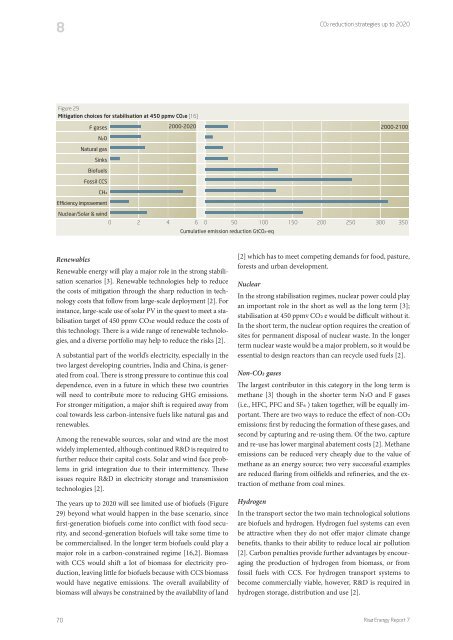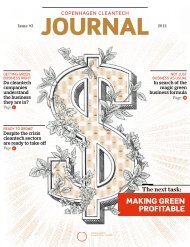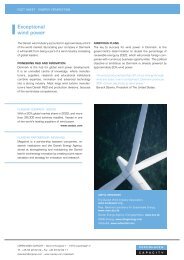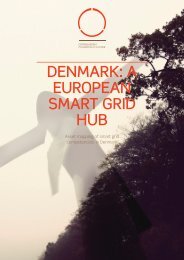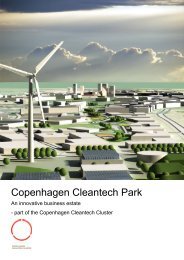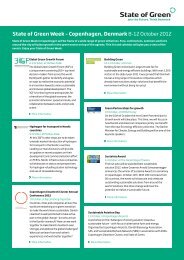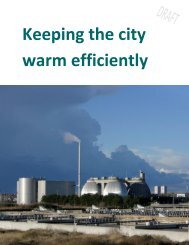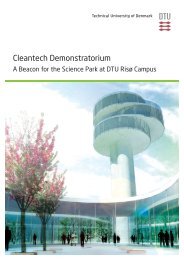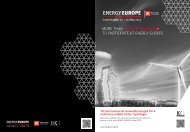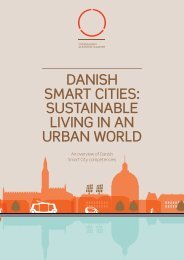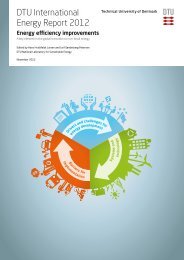Future low carbon energy systems - Copenhagen Cleantech Cluster
Future low carbon energy systems - Copenhagen Cleantech Cluster
Future low carbon energy systems - Copenhagen Cleantech Cluster
You also want an ePaper? Increase the reach of your titles
YUMPU automatically turns print PDFs into web optimized ePapers that Google loves.
8CO ² reduction strategies up to 2020Figure 29Mitigation choices for stabilisation at 450 ppmv CO ² e [16]F gases2000-2020 2000-2100N ² ONatural gasSinksBiofuelsFossil CCSCH4Efficiency improvementNuclear/Solar & wind0 2 46 0 50 100 150 200 250 300 350Cumulative emission reduction GtCO ² -eqRenewablesRenewable <strong>energy</strong> will play a major role in the strong stabilisationscenarios [3]. Renewable technologies help to reducethe costs of mitigation through the sharp reduction in technologycosts that fol<strong>low</strong> from large-scale deployment [2]. Forinstance, large-scale use of solar PV in the quest to meet a stabilisationtarget of 450 ppmv CO2e would reduce the costs ofthis technology. There is a wide range of renewable technologies,and a diverse portfolio may help to reduce the risks [2].A substantial part of the world’s electricity, especially in thetwo largest developing countries, India and China, is generatedfrom coal. There is strong pressure to continue this coaldependence, even in a future in which these two countrieswill need to contribute more to reducing GHG emissions.For stronger mitigation, a major shift is required away fromcoal towards less <strong>carbon</strong>-intensive fuels like natural gas andrenewables.Among the renewable sources, solar and wind are the mostwidely implemented, although continued R&D is required tofurther reduce their capital costs. Solar and wind face problemsin grid integration due to their intermittency. Theseissues require R&D in electricity storage and transmissiontechnologies [2].The years up to 2020 will see limited use of biofuels (Figure29) beyond what would happen in the base scenario, sincefirst-generation biofuels come into conflict with food security,and second-generation biofuels will take some time tobe commercialised. In the longer term biofuels could play amajor role in a <strong>carbon</strong>-constrained regime [16,2]. Biomasswith CCS would shift a lot of biomass for electricity production,leaving little for biofuels because with CCS biomasswould have negative emissions. The overall availability ofbiomass will always be constrained by the availability of land[2] which has to meet competing demands for food, pasture,forests and urban development.NuclearIn the strong stabilisation regimes, nuclear power could playan important role in the short as well as the long term [3];stabilisation at 450 ppmv CO2 e would be difficult without it.In the short term, the nuclear option requires the creation ofsites for permanent disposal of nuclear waste. In the longerterm nuclear waste would be a major problem, so it would beessential to design reactors than can recycle used fuels [2].Non-CO2 gasesThe largest contributor in this category in the long term is(i.e., HFC, PFC and SF6 ) taken together, will be equally important.There are two ways to reduce the effect of non-CO2emissions: first by reducing the formation of these gases, andsecond by capturing and re-using them. Of the two, captureand re-use has <strong>low</strong>er marginal abatement costs [2]. Methaneemissions can be reduced very cheaply due to the value ofmethane as an <strong>energy</strong> source; two very successful examplesare reduced flaring from oilfields and refineries, and the extractionof methane from coal mines.HydrogenIn the transport sector the two main technological solutionsare biofuels and hydrogen. Hydrogen fuel <strong>systems</strong> can evenbe attractive when they do not offer major climate changebenefits, thanks to their ability to reduce local air pollution[2]. Carbon penalties provide further advantages by encouragingthe production of hydrogen from biomass, or fromfossil fuels with CCS. For hydrogen transport <strong>systems</strong> tobecome commercially viable, however, R&D is required inhydrogen storage, distribution and use [2].70Risø Energy Report 7


